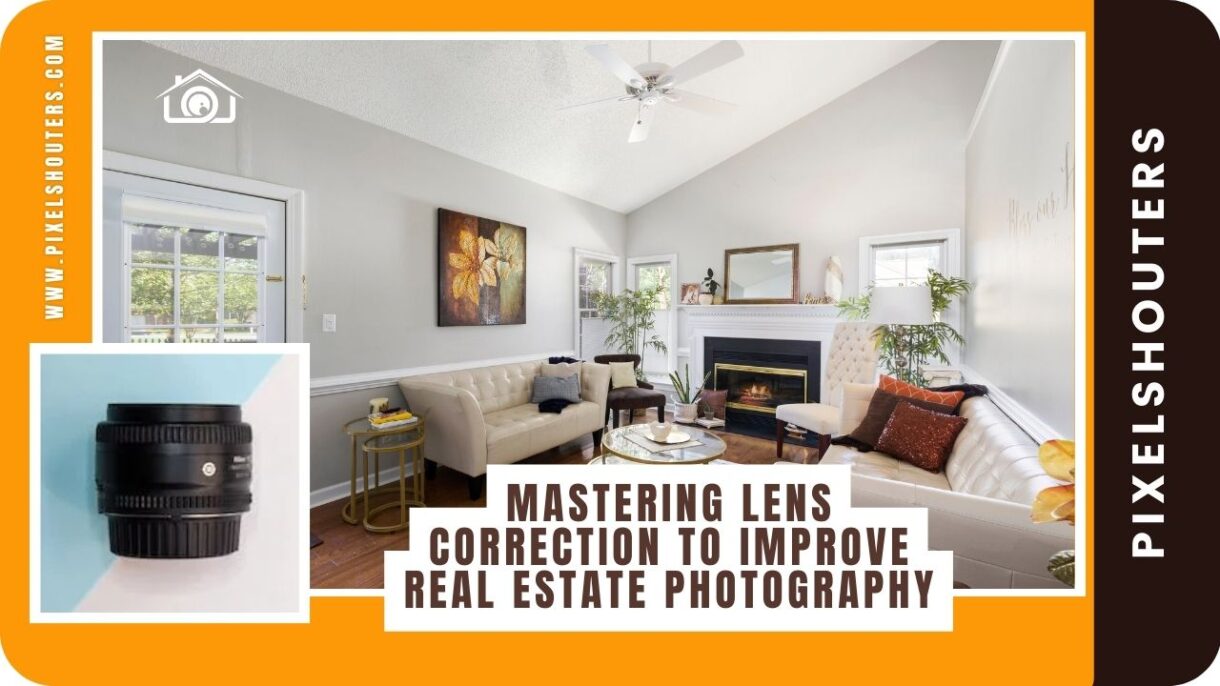Mastering Lens Correction to Improve Real Estate Photography
In real estate photographs wherein every image tells approximately a property, the significance of precision and excellence can’t be overstated. In this subject, lens correction is used as a technique that is essential for refining pix and making them extra accurate representations of the spaces they depict. It offers a complete examination of the complexities, techniques, and effects of lens correction in real estate photography.
Table of Contents
Understanding Lens Distortions:
However, before you visit to learn about lens correction you want to recognize what lens distortions mean. These are deviations from a perfect mild projection on the digicam sensor that could exhibit themselves through different types with particular peculiarities each.
- Barrel Distortion – Barrel distortion is typically located in huge-angle lenses wherein instantly strains seem to bend outwards like in a barrel. This impact tends to magnify items near the rims of the body thereby distorting one’s perception of spatial dimensions.

- Pincushion Distortion: On the other hand, pincushion distortion makes horizontal lines appear curved inward whilst vertical lines deliver an impact that they curve outward like a cushion’s form. This state is not unusual for telephoto lenses especially while zooming in growing resultant compression at the essential part of the image.
- Chromatic Aberration: Another form of distortion, chromatic aberration, happens while exclusive wavelengths of mild are refracted in a different way by means of the lens. The result of this phenomenon is color fringing that looks at excessive contrast edges in a picture accordingly affecting its ordinary sharpness and accuracy.
By managing the one’s distortions again to their particular motive and consequences, photographers may be capable of apprehending how they may be able to accurate any lens successfully.
Techniques for Lens Correction:
In the pursuit of precise and visually compelling imagery, photographers can employ a myriad of techniques to rectify lens distortions. These techniques, ranging from software-based corrections to manual adjustments, offer versatile solutions tailored to the unique demands of each photographic scenario.
1. Software-Based Correction:
- Automatic Lens Profile Corrections: Modern editing software, such as Adobe Lightroom and Photoshop, feature robust algorithms capable of automatically detecting and correcting lens distortions based on preloaded lens profiles. These tools streamline the correction process, enabling photographers to achieve consistent results with minimal manual intervention.
- Manual Distortion Correction: For scenarios where automatic correction falls short, photographers can resort to manual adjustments to fine-tune lens distortions. This approach grants unparalleled control over the correction process, empowering photographers to tailor corrections to specific regions of the image with precision and finesse.
2. Manual Correction Methods:
- Lens Profiles and Corrections: Many lens manufacturers provide proprietary lens profiles that can be integrated into editing software, facilitating accurate and efficient corrections tailored to each lens’s unique characteristics. By leveraging these profiles, photographers can expedite the correction process while ensuring optimal results.
- Perspective Control Tools: In instances where geometric distortions, such as perspective distortion, are prevalent, photographers can utilize specialized perspective control tools to rectify these anomalies manually. These tools enable photographers to manipulate the perspective of the image, effectively correcting distortions and enhancing the image’s overall visual coherence.
By embracing a holistic approach that combines the strengths of software-based corrections and manual adjustment methods, photographers can unlock the full potential of lens correction and elevate the quality of their real estate photography.
Importance of Lens Correction in Real Estate Photography:
In the competitive landscape of real estate marketing, where visual assets serve as the primary means of captivating potential buyers, the significance of lens correction cannot be overstated. Lens correction plays a pivotal role in enhancing the quality, accuracy, and visual appeal of real estate imagery, thereby empowering photographers to showcase properties in their best light and entice prospective buyers.
1. Enhancing Image Quality:
Lens correction serves as a cornerstone for enhancing image quality by mitigating distortions and imperfections that detract from the overall visual fidelity of the image. By rectifying distortions such as barrel distortion and chromatic aberration, photographers can ensure that architectural elements and spatial dimensions are faithfully represented, resulting in images that exude professionalism and attention to detail.

2. Ensuring Accuracy in Representing Spaces:
In the realm of real estate photography, where properties are meticulously staged and curated to resonate with potential buyers, accuracy in representation is paramount. Lens correction enables photographers to capture images that faithfully depict the scale, proportions, and spatial layout of properties, instilling confidence in prospective buyers and facilitating informed decision-making.
3. Impact on Marketing and Sales:
In an era where visual content reigns supreme in the realm of digital marketing, the quality and visual appeal of real estate imagery directly influence marketing effectiveness and sales outcomes. By leveraging lens correction to elevate the quality and professionalism of their imagery, photographers can captivate audiences, differentiate their listings from competitors, and ultimately drive engagement and conversions.
Tips for Effective Lens Correction:
Mastering lens correction is a nuanced and iterative process that requires a combination of technical proficiency, creative insight, and attention to detail. To navigate this terrain effectively, photographers can benefit from incorporating the following tips into their workflow:
1. Shoot with Lens Corrections in Mind:
Prioritize shooting techniques and compositions that minimize lens distortions, such as avoiding extreme angles and focal lengths whenever possible. By adopting a proactive approach to lens correction during the shooting phase, photographers can streamline the correction process in post-production and achieve superior results.
2. Use Quality Lenses:
Invest in high-quality lenses renowned for their optical performance and minimal distortion characteristics. Quality lenses not only minimize lens distortions at the source but also offer superior image quality and sharpness, laying the groundwork for exceptional real estate photography.
3. Experiment with Different Correction Techniques:
Familiarize yourself with a diverse array of correction techniques and tools, ranging from automatic corrections in editing software to manual adjustments using perspective control tools. By exploring various correction methods and refining your proficiency in each, you can develop a nuanced understanding of lens correction and tailor your approach to suit the unique demands of each photographic scenario.
4. Regularly Update Lens Profiles:
Stay abreast of updates and advancements in lens profiles provided by manufacturers, ensuring that your editing software is equipped with the latest corrections tailored to your lenses. Regularly updating lens profiles ensures optimal accuracy and compatibility, enabling photographers to achieve consistent results and maintain the integrity of their imagery.

Conclusion:
In the realm of real estate photography, where every image serves as a visual gateway to properties and spaces, the mastery of lens correction emerges as a cornerstone for elevating the quality, accuracy, and visual appeal of imagery. By unraveling the complexities of lens distortions, embracing versatile correction techniques, and prioritizing accuracy in representation, photographers can embark on a transformative journey towards mastering lens correction and setting new standards of excellence in real estate photography.
Through a holistic approach that integrates technical proficiency, creative insight, and meticulous attention to detail, photographers can unlock the full potential of lens correction and craft imagery that resonates with audiences, captivates prospective buyers, and drives engagement and conversions in the competitive landscape of real estate marketing.
